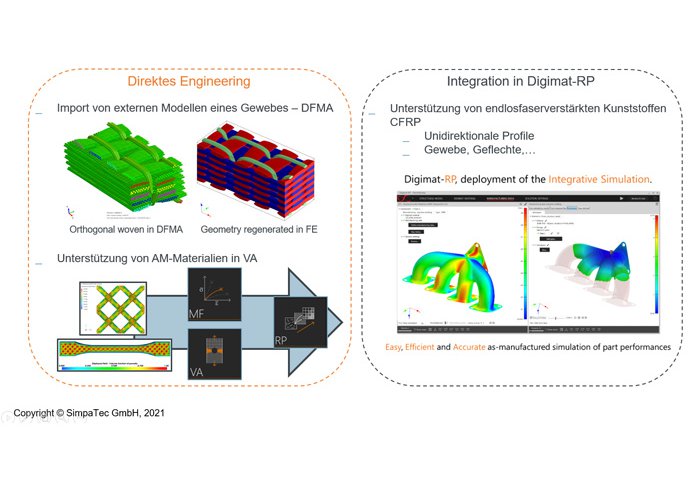
Extended range of functions in Digimat-RP 2021.4 (Q4) for CFRP
ESPECIALLY FOR OUR USERS
Using the direct-engineering-method for continuous reinforced composites (CFRP), for one, the behavior of the material system can be calculated and analyzed and for the other the material map can be used in an integrative simulation. Unused optimization potential with regard to the microstructure as well as the macroscopic component behavior can be identified and appropriate measures can be initiated. Previous workflows dealing with coupled simulations involved a manual exchange of material cards with the subroutine. The new release of Digimat 2021.4 includes an integration of the continuous reinforced plastics in Digimat-RP, which ensures an automated workflow.
An optimal design of composites subjected to unidirectional profiles, fabrics, braids, etc. requires a deeper understanding of the material system as well as the microstructure. The direct engineering of continuous reinforced plastics offers the necessary added value to investigate, understand and optimize the material behavior under subsequent loads. The traditional workflow includes the "trial and error" method where experimental tests are performed after every modification of the microstructure to determine the current material characteristics. Previous "state-of-the-art" methods include the classical laminate structure in the pre-processor according to the general laminate theory. The quality of the results take place on a macroscopic level - in contrast to the micromechanical approach with higher quality.
Improvements in future Digimat versions 2021.3 and 2021.4 will make workflows more efficient, requiring less labor and calculation time. Enhanced FFT solver support enables shorter calculation times in combination with new meshing technologies. This significantly accelerates the workflow in terms of direct engineering so that material behavior can be tested at an early stage at the macroscopic component level.
To achieve a more efficient workflow CFRP materials are supported when using Digimat-RP. Due to this integration into Digimat-RP, there is no need to manually assemble a coupled analysis via the classic CAE route. Lower susceptibility, fast reproducibility of analyses, significantly less work for the user are only some of the advantages resulting from this. Further improvements in the support of manufacturing processes will be incorporated in the upcoming software optimizations. In Digimat-VA (Virtual Allowables), for example, it will be possible to analyze, calculate and optimize 3D printing materials and then use them with an optimized microstructure in an integrative simulation.
Accordingly, the new features will close a holistic simulation chain, making the workflow more convenient and automated.
Finally, the last release of the Digimat 2021 version will complement the functional scope of direct engineering as well as simplify the daily application with new features.
We are happy to support to consult you in all matters as well as in realizing characterizations right up to calibrated material cards for direct use in our in-house simulation tools.
